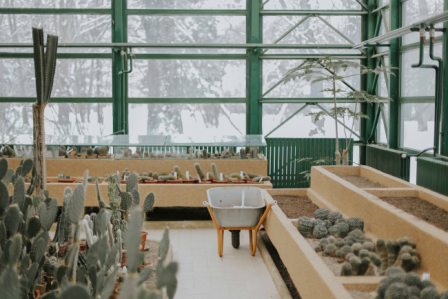
A greenhouse can be the avid gardener’s best friend during the winter months. Greenhouses make it possible for us to extend the lifespan of our valuable plants, and sometimes even over winter them so they can enjoy yet another growing season next year. If you already own a greenhouse or are thinking of buying one, there are several important things to consider when it comes to prepping your greenhouse for winter use.
The primary consideration in winter use of any greenhouse is your local climate. How cold does it get in your area? If you experience harsh winters full of snow and ice, using your greenhouse all year long will be very difficult and possibly quite costly. If your region experiences milder winters, with nighttime temperatures sometimes dipping near the freezing range, extended winter use of your greenhouse will be easier.
It’s also important to ask yourself, what types of plants will you keep in your greenhouse during the winter months? What range of temperature do those plants require? In general, you want to over winter plants that can tolerate some fairly cool weather. Warm weather tropical plants that are very sensitive to the cold will not do well in an outdoor greenhouse during cold winter months.
Once you’ve determined the type of plants you’ll be growing and the lowest possible temperatures of your local area, you’re ready to consider alternate heat sources for your greenhouse. Remember, daytime temps in a greenhouse will usually reach 20 to 40 degrees warmer than the outside air. At night, however, the air inside the greenhouse will fall to about the same temperature as the cool night air outside. This is the time when you have to protect your plants from possible freezing in your greenhouse.
If the nighttime temperatures will only dip to the 50 or 60 degree range, and you have fairly hardy plants in your greenhouse, you may not have to provide any alternate heat source at all. A very easy and inexpensive way to provide a little additional heat is to place several very large rocks or buckets of water inside the greenhouse. During the day, the rocks and water will absorb the heat from the ambient air. At night, they will then radiate that heat back out into the greenhouse.
If you’re dealing with much colder nighttime temperatures, such as into the freezing range, you’ll likely have to bring in some small electric heaters. Look for a portable heater that is specifically designed for use in greenhouses. Such heaters will usually feature thermostats and auto on-off switches that are programmable. A greenhouse heater is also designed to run for quite a few hours at a time, if needed, without overheating.
Last but not least, if you do have some snow accumulation in your area, be sure you remove the snow from your greenhouse as quickly as possible. Snow on the roof or sides of your greenhouse will reduce or completely eliminate any possible solar gain during the daytime. Furthermore, if you get too much snow on top of a greenhouse, even one that isn’t in use in the winter, you have to worry about snow load on the roof and possible damage to the structure. In any case, it’s always a good idea to keep snow brushed off the roof on a regular basis.
Greenhouse gardening during the colder winter months isn’t impossible, particularly if you live in a mild climate. With a few simple steps and some pre-planning, you’ll be well on your way to raising beautiful plants the year around.
Ellen Bell works for a retail website that offers a complete line of wholesale greenhouse supplies for winter greenhouses.
Related Articles & Free Email Newsletter
Deciding Between a Lean-To or Attached Greenhouse
The Good and Bad of Glass Greenhouses




Comment here